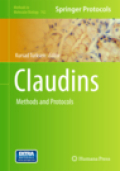
Since the initial discovery of the claudins, the field of tight junctions andcell polarity has become increasingly energized, mainly due to the fact that the claudins have provided an opportunity to understand the molecular basis ofthe tight junction function and their tissue specific roles. In Claudins: Methods and Protocols , experts and pioneers in the field provide an extensive collection of techniques involving these tight junction proteins. Written in the highly successful Methods in Molecular Biology™ series format, chapters include brief introductions to their respective topics, detailed lists of the necessary materials and reagents, step-by-step, readily reproducible laboratory protocols, and key tips on troubleshooting and avoiding known pitfalls. Authoritative and practical, Claudins: Methods and Protocols serves as an ideal guidefor all scientists seeking to further our understanding of this vital area ofresearch. Collects key practical protocols for the study of claudins. Serves as the first comprehensive volume of techniques involving this subject. Features tipsand vital implementation advice to ensure success. INDICE: Measuring Size-Dependent Permeability of the Tight Junction Using PEG Profiling. Biochemical Analysis of Claudin Binding Compatibility. Electrophysiological Characterization of Claudin Ion Permeability Using Stably Transfected Epithelial Cell Lines. The Tight Junction, Intercellular Seal as a Cell Signaling Player: Protocols for Examination of Its Status. Interactions betweenClostridium perfringens Enterotoxin and Claudins. Biophysical Methods to Probe Claudin Mediated Adhesion at the Cellular and Molecular Level. Detection of Tight Junction Barrier Function In Vivo by Biotin. The Co-Culture Method to Examine Interactions between Claudin Isoforms in Tight Junction-Free HEK293 Cells and Tight Junction-Bearing MDCK II Cells. Claudin 4: Functional Studies Beyond the Tight Junction. Methods to Analyze Subcellular Localization and Intracellular Trafficking of Claudin 16. Claudin Family Proteins in C. elegans. In Vivo Imaging of Tight Junctions Using Claudin-EGFP Transgenic Medaka. Claudins in a Primary Cultured Puffer Fish ( Tetraodon nigroviridis ) Gill Epithelium. Manipulating Claudin Expression in Avian Embryos. Identification of Claudins byWestern Blot and Immunofluorescence in Different Cell Lines and Tissues. Expression and Function of Claudins in Hepatocytes. Analysis of Changes in the Expression Pattern of Claudins Using Salivary Acinar Cells in Primary Culture. Development of Biological Tools to Study Claudins in the Male Reproductive Tract. Using Molecular Tracers to Assess the Integrity of the Intestinal EpithelialBarrier In Vivo. Laboratory Methods in the Study of Endometrial Claudin-4. Role of Claudins in Oxidant-Induced Alveolar Epithelial Barrier Dysfunction. Tracing the Endocytosis of Claudin-5 in Brain Endothelial Cells. Quantitative In Situ Analysis of Claudin Expression at the Blood-Retinal Barrier. MMP-MediatedDisruption of Claudin-5 in the Blood-Brain Barrier of Rat Brain after Cerebral Ischemia. Claudin-5 Expression in In Vitro Models of the Blood-Brain Barrier. HIV-1-Induced Alterations of Claudin-5 Expression at the Blood Brain BarrierLevel. Enhanced Immunohistochemical Resolution of Claudin Proteins in Glycolmethacrylate-Embedded Tissue Biopsies. Claudin-16/Paracellin-1, Cloning, Expression, and Its Role in Tight Junction Functions in Cancer and Endothelial Cells. Dynamics of Claudins Expression in Colitis and Colitis-Associated Cancer in Rat. Anti-Claudin 4 Conjugated Highly Luminescence Nanoparticles as BiologicalLabels for Pancreatic Cancer Sensing.
- ISBN: 978-1-61779-184-0
- Editorial: Humana Press
- Encuadernacion: Cartoné
- Páginas: 455
- Fecha Publicación: 29/07/2011
- Nº Volúmenes: 1
- Idioma: Inglés
